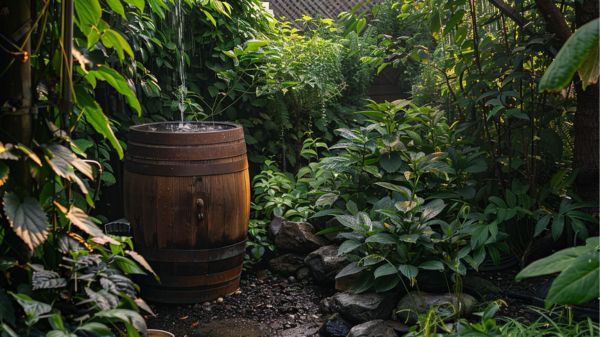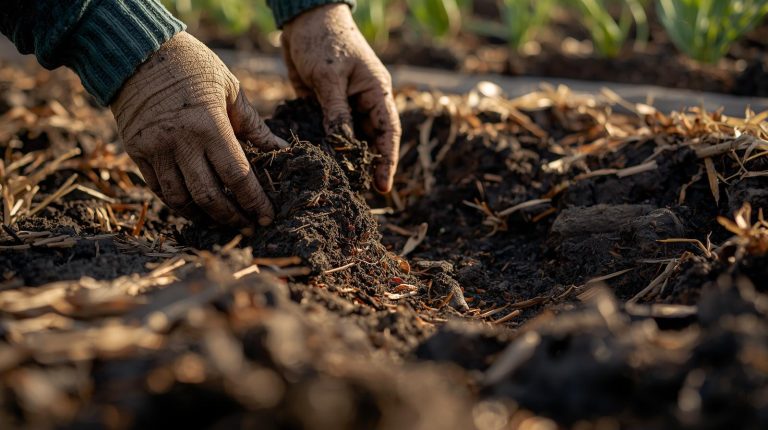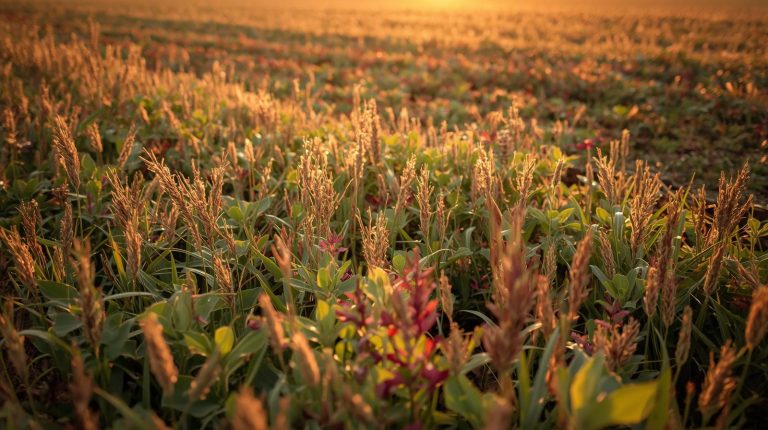Efficient rainwater collection using proper barrels is essential for sustainable water management. Benefits include water conservation, free water for landscaping, erosion prevention, and controlling moisture levels. Choose food-grade plastic for purity, avoid rust-prone metal or rot-prone wood.
Proper placement and support, along with regular maintenance, guarantee functionality. Filtration prevents contamination, and rain chains enhance efficiency. Maintain systems by cleaning, insulating, and redirecting overflow. Utilize harvested rainwater for plant irrigation and outdoor cleaning. Essential steps for successful rainwater collection are vital for sustainable living and water conservation practices.

Key Takeaways
- Choose food-grade plastic barrels for purity and durability.
- Proper setup includes meticulous placement and support.
- Prevent contamination with effective filtration and clean storage.
- Utilize rain chains for enhanced efficiency and customization.
- Regular maintenance, cleaning, and winter precautions ensure system longevity.
Benefits of Rainwater Collection Barrels
Rainwater collection barrels offer numerous advantages, making them a valuable and sustainable addition to any property. Water conservation is a critical aspect of sustainable living, and rainwater harvesting through these barrels plays a pivotal role in this endeavor. By collecting rainwater that would otherwise run off rooftops and into the ground, these barrels provide a free source of water for landscaping needs. This practice reduces the reliance on municipal water sources, ultimately contributing to water conservation efforts.
Aside from the direct benefits of water conservation, rainwater barrels also help prevent erosion and flooding by capturing excess rainwater runoff. This not only protects the property but also contributes to overall environmental preservation. Using rainwater barrels can help control moisture levels around foundations, mitigating the risk of water damage and promoting a healthier environment. Essentially, rainwater collection barrels offer a simple yet effective way to harness nature’s gift for sustainable living practices.
Choosing the Right Barrel Material
When selecting the appropriate material for rainwater collection barrels, it is essential to choose food-grade plastic to guarantee the safety and purity of the harvested water. Food-grade plastic barrels are crafted to store consumable items, ensuring that no harmful chemicals leach into the water.
These barrels are an excellent choice for water storage as they are non-toxic and do not contaminate the water with any harmful substances. It is important to avoid using barrels that previously held petroleum products or chemicals, as these can pose a risk of contamination to the collected water.
| Material | Description | Benefits |
|---|---|---|
| Food-Grade Plastic | Non-toxic, safe for water storage | Maintains water purity and safety |
| Metal | Can rust and contaminate water | Not suitable for extended water storage |
| Wood | Prone to rot and may leak | Risk of water pollution |
Choosing food-grade plastic barrels, typically ranging from 50 to 80 gallons in size, with sealed lids is essential to preserving the quality of the harvested water. Opting for high-quality plastic ensures the durability and longevity of the rainwater collection system, providing a dependable water source for various purposes.
Related Post: 10 Best Barrels for Rainwater Collection to Save the Environment.
Setting Up Your Rainwater Collection System
To establish an efficient rainwater collection system, meticulous placement of the barrel in proximity to roof valleys or a modified downspout is vital for best water diversion. By positioning the rain barrel strategically, you can maximize the amount of water collected during rainfall.
It is important to guarantee the barrel is situated on level ground with proper support to prevent tipping, especially when it becomes heavy with water. Connecting the rain barrel to a downspout diverter facilitates the collection process, allowing rainwater to flow directly into the barrel.
Regularly inspect the system for leaks, damage, and debris to maintain functionality and prevent potential issues. After installation, testing the system for leaks and overall functionality is recommended to guarantee proper operation.
Proper setup and maintenance of your rainwater collection system will ensure a reliable supply of water for various purposes while promoting sustainability.
Preventing Contamination in Rainwater
To guarantee the quality of rainwater collected in barrels, it is essential to implement effective filtration methods that remove debris and potential contaminants. Additionally, maintaining clean storage containers and roofs can help prevent the introduction of harmful substances into the collected water.
Filter Rainwater Effectively
Effectively filtering rainwater is vital in preventing contamination and ensuring its suitability for various uses. To filter rainwater, utilize a screen to remove debris and large particles that could introduce contaminants into the collected water.
Regular maintenance is essential; clean the screens and tanks frequently to eliminate potential contaminants such as leaf litter and bird droppings. Rain barrel water should not be used on edible plants to minimize the risk of contamination. Chemicals from roof materials can also contaminate rainwater, rendering it unsuitable for consumption.
To safeguard plant health, reserve rain barrel water for inedible plants like lawns, flowers, shrubs, or trees, where the impact of contaminants is less critical.
Maintain Clean Storage
Maintaining clean storage in rainwater collection barrels is crucial to prevent contamination and guarantee water quality for various uses. Debris and contaminants can enter the rain barrel through the roof runoff, impacting the quality of the rain barrel water. It is essential to clean the screens and tank regularly to remove debris and prevent contamination.
Using a sealed lid is also important to prevent external contaminants like bird droppings from entering the barrel. Chemicals from roofing materials can contaminate rainwater, so it’s advisable to use the water on inedible plants rather than edible ones. Regular maintenance is key to ensuring clean storage and preventing the negative effects of contaminants on plant health.
| Maintenance Tips | Description | Importance |
|---|---|---|
| Clean screens and tank | Remove debris to prevent contamination | High |
| Use sealed lid | Prevent external contaminants | Medium |
| Avoid edible plants | Minimize risk of contamination | Medium |
Prevent Bacterial Growth
Contaminants in rainwater collection barrels can lead to bacterial growth, necessitating proactive measures to prevent contamination and maintain water quality. To safeguard your rainwater and guarantee its purity, follow these essential steps:
- Regular Cleaning: Clean the rain barrel regularly to prevent the buildup of bacteria and contaminants.
- Sealed Lid: Use a sealed lid to keep out debris and pests that could introduce harmful bacteria into the water.
- Avoid Chemicals: Refrain from using chemicals or soaps near the rain barrel to prevent contamination of the rainwater.
- Shaded Positioning: Place the rain barrel in a shaded area to reduce bacterial growth facilitated by sunlight exposure.
Maximizing Efficiency With Rain Chains
When considering rainwater collection systems, incorporating rain chains can greatly enhance the efficiency of capturing and storing rainwater. Rain chains serve as decorative alternatives to traditional downspouts, guiding rainwater from the roof into the rain barrel.
They come in various materials such as copper, aluminum, or steel, not only adding aesthetic appeal but also providing a functional and visually pleasing way to facilitate rainwater harvesting. The soothing visual and auditory experience created as rainwater cascades down the chain into the barrel adds a unique dimension to the process.
These chains are easy to install and maintain, making them a practical choice for maximizing rainwater collection efficiency. Additionally, rain chains can be customized in length and design, allowing for adaptation to different roof styles and individual preferences. By incorporating rain chains into your rainwater harvesting system, you not only enhance efficiency but also create a beautiful and sustainable water collection solution.
Maintenance Tips for Rain Barrels
Regular inspection and maintenance of rain barrels are vital to guarantee peak performance and longevity in rainwater harvesting systems. To safeguard the efficiency and durability of your rain barrel, follow these maintenance tips:
- Drain and Disconnect: In winter, drain and disconnect the rain barrel to prevent cracking and damage caused by freezing temperatures.
- Clean Screens and Tank: Periodically clean screens and the tank to remove debris, ensuring proper functionality and water quality.
- Redirect Overflow: Lead the overflow hose to a garden or rain garden to effectively manage excess water and prevent overflow issues.
- Prevent Freezing: Avoid freezing and thawing by insulating the rain barrel to prevent structural damage and maintain the integrity of the system.
Regular maintenance not only safeguards your investment but also contributes to the sustainable use of water resources through efficient harvesting of rainwater. By following these simple yet vital steps, you can optimize the performance of your rain barrel and support the conservation of water.
Utilizing Rainwater for Various Purposes
Rainwater collected in barrels can be efficiently used for watering plants, lawns, and gardens, providing a sustainable water source for vegetation. Additionally, rainwater is suitable for cleaning outdoor spaces like cars, tools, and outdoor furniture, reducing the need for treated water.
Watering Plants Efficiently
Utilizing rainwater collected in barrels for plant irrigation offers a sustainable and cost-effective solution to efficiently water plants while conserving valuable drinking water resources. Rainwater is free of chlorine and other chemicals, benefiting plant health, and reducing the need for municipal water.
By using rain barrels, individuals can support eco-friendly practices, especially during dry periods, ensuring a vital supply of water for plant watering. This method not only helps in reducing water bills but also plays an essential role in conserving precious drinking water resources.
Overall, rainwater harvesting for plant irrigation provides a practical and environmentally conscious approach to watering plants, promoting water conservation and sustainability.
- Rainwater collected in barrels can efficiently water plants, reducing the need for municipal water.
- Using rainwater for plant irrigation helps conserve precious drinking water resources.
- Rainwater is free of chlorine and other chemicals, making it beneficial for plant health.
- Rain barrels provide a sustainable way to water plants during dry periods.
Cleaning Outdoor Spaces
Incorporating harvested rainwater into outdoor cleaning practices offers a sustainable and resource-conscious approach to maintaining cleanliness in outdoor spaces. Rainwater collected in barrels can efficiently clean outdoor areas such as patios, decks, and driveways. This harvested water, free of chlorine and chemicals, is ideal for cleaning tools, equipment, and outdoor furniture effectively.
By utilizing rainwater for outdoor cleaning, individuals can reduce their reliance on treated water, contributing to water conservation efforts and lowering water bills. This practice not only conserves resources but also promotes a more eco-friendly lifestyle.
Embracing the use of rainwater to clean outdoor spaces showcases a practical and environmentally responsible way to enhance cleanliness while minimizing the impact on precious water supplies.

Frequently Asked Questions
What Should I Look for in a Good Rain Barrel?
A high-quality rain barrel should feature a sealed lid, screen or filter, overflow outlet, and a spigot or faucet for top-notch functionality. Prioritize these aspects for efficient rainwater collection. Installation and maintenance are critical for long-term use.
Does It Matter What Color a Rain Barrel Is?
The color of a rain barrel matters for various reasons. Dark colors absorb heat and can prevent algae growth, while light colors are ideal for warmer climates to avoid water overheating. Consider aesthetics, UV protection, water conservation, and environmental impact when choosing a color.
Does a Rain Barrel Need to Be Food Grade?
When contemplating rain barrel selection, prioritizing food-grade materials for storage is essential. Food-grade barrels guarantee material safety and compliance with regulations, safeguarding water quality. Opting for non-food grade alternatives may compromise water purity and durability.
How Do You Keep Water Good in a Rain Barrel?
To keep water good in a rain barrel, implement water treatment methods like filtration or adding chlorine. Regular maintenance tips include cleaning screens, using sealed lids, managing overflow, and inspecting for leaks. These practices guarantee water quality for various uses.
Related Post: Ultimate Rainwater Harvesting Techniques for Sustainable Living.
Conclusion
To sum up, rainwater collection barrels offer numerous benefits, such as reducing water bills and conserving resources. By selecting the appropriate barrel material, setting up the system properly, preventing contamination, and utilizing rain chains, you can maximize efficiency and make the most of collected rainwater.
Regular maintenance is crucial to guarantee the longevity and effectiveness of rain barrels. With proper care and attention, rainwater can be utilized for various purposes, contributing to sustainability and resource conservation.




